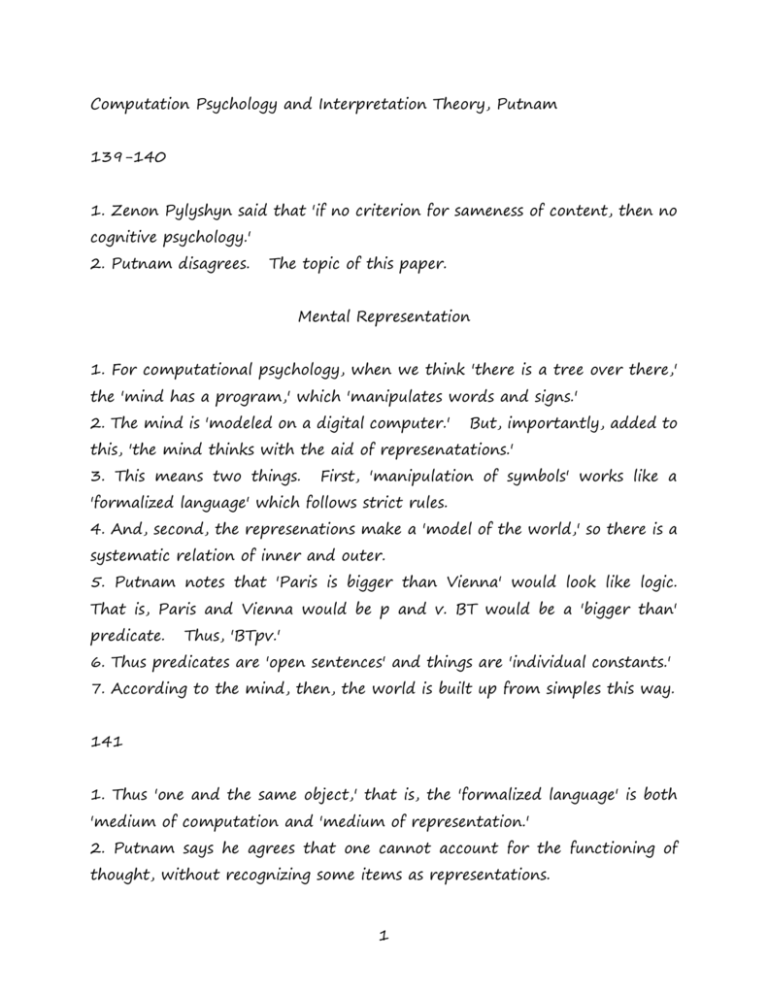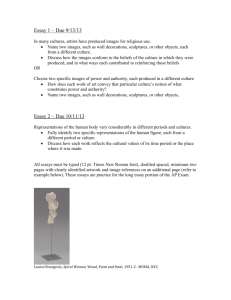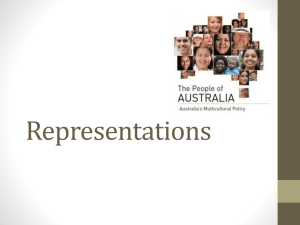Computation Psychology and Interpretation Theory, Putnam 139
advertisement

Computation Psychology and Interpretation Theory, Putnam 139-140 1. Zenon Pylyshyn said that 'if no criterion for sameness of content, then no cognitive psychology.' 2. Putnam disagrees. The topic of this paper. Mental Representation 1. For computational psychology, when we think 'there is a tree over there,' the 'mind has a program,' which 'manipulates words and signs.' 2. The mind is 'modeled on a digital computer.' But, importantly, added to this, 'the mind thinks with the aid of represenatations.' 3. This means two things. First, 'manipulation of symbols' works like a 'formalized language' which follows strict rules. 4. And, second, the represenations make a 'model of the world,' so there is a systematic relation of inner and outer. 5. Putnam notes that 'Paris is bigger than Vienna' would look like logic. That is, Paris and Vienna would be p and v. BT would be a 'bigger than' predicate. Thus, 'BTpv.' 6. Thus predicates are 'open sentences' and things are 'individual constants.' 7. According to the mind, then, the world is built up from simples this way. 141 1. Thus 'one and the same object,' that is, the 'formalized language' is both 'medium of computation and 'medium of representation.' 2. Putnam says he agrees that one cannot account for the functioning of thought, without recognizing some items as representations. 1 3. Where there is room for argument is how many mental items or functions are representations. Verificationist Semantics of Mentalese 142 1. Putnam notes that the above assumes that there is but one formal language, as opposed different ones for different modules, or other complications. 2. He grants this for the sake of simplicity and argument, but doubts it of course. 3, But, this is key 'in what does the minds understanding of its own medium of computation consist?' 4. In other words how does this 'analog,' this 'mentalese' understand itself. 5. 'Mentalese' understands itself, Putnam suggests, via 'verificaionist semantics.' 6. There is an automatic 'computable predicate.... that represents acceptability, warranted assertability, or credibility' for 'sentence analogs.' 7. This predicate is automatic because it works 'via a set of rules.' 8. It 'assigns degress of confirmation,' relative to experiential input, and other computable states. Note: This seems to work by a verification predicate which works via rules. In accordance with its rules, it verifies or rejects information in relation to new information and old representations. 143 1. Putnam says that only verification semantics gives a psychological notion of 2 'use' for sentences of mentalese. 2. It 'has a notion of belief or degree of belief, and that makes it cognitive.' This is the verification function. 3. And, 'it also has a notion of computation, and that makes it functionalist.' This is the representational theory of mind. The manipulation of symbols. 4. But, Putnam notes, this is all banal unless we connect it to action. also need a 'utility function,' So we some preference analog. 5. This also must be computable. Remember this is the assumption of the theory. Note: In sum, we seem to need an understanding analog. verificationist semantics. A 'computable... degree of confirmation predicate.' And, we need an action or preference analog. verification. This is provided by This is not provided by It is provided by a 'computable.. utility predicate.' Putnam notes the idealist nature of all this. Two Ruritanian Children 144 1. There is a north and south of this country. 2. In the north 'grug' means 'silver.' 3. In the south 'grug' means 'aluminum.' 4. North makes pots and pans from silver. South makes them from aluminum. 5. There are two people, Elmer and Oscar. Elmer is from the north; Oscar from the south. 6. So, northern kids grow up, thinking pots etc are made of 'grug.' Southern kids grow up thinking pots etc are made of 'grug.' 7. Now Elmer and Oscar are identical in 'mental representation' in the head. 3 8. They have the same, in the head, beliefs. Note: I assume that Putnam must mean 'in the head' here. I put that in. 9. But 'some of their beliefs will differ in meaning, even though they are the same in 'mental representations.' 10. Putnam cites the difference that 'my' mother has grug is indexical. Difference in mothers. 11. This of course, 'gives up the distinction between meaning and information.' Any change in information is change in meaning that is. 12. In footnote, this 'picture' of 'meaning in the head' to be useful, 'mental representations and their content must remain stable through some changes in belief.' 145 1. In 'Meaning of Meaning' Putnam argued 'meaning aint in the head.' 2. For 'difference in reference in two communities infects difference in meaning.' 3. When Elmer or Oscar determines 'what grug means' they will have to rely on experts. 4. Putnam says: a. since extension is different in different communities b. since different extension is different meaning on this theory of meaning. c. since extension is fixed collectively by people with varying knowledge d. this means that 'meaning is not the same even though nothing psychologically different about the twins.' 4 there is 5. But, Zenon P., and Chomsky 'want to factor out objective differences in extension. 6. They need a concept of content where 'grug' in the north and south would be the same. 146 1. But, Putnam asks, if Elmer and Oscar have the same content now, when they know little, 'when do they come to differ in content.' 2. He notes, by the time they are grown up, each 'will know the difference of silver or aluminum,' and will have a different conception of grug. 3. But, on the 'verificationist model' of meaning 'there is no point when a mental representation changes its reference.' 4. As opposed to just 'collecting new collateral information' about the same reference. 4. From the 'internal point of view' to 'change reference would be to change representation.' 5. So, 'there is nothing on this functionalist... internal representationist model, that tells us when a representation has changed its content.' Note: The problem, then, is that we have no criterion for mental representations to say when we just get new information about the same things, or the representations are about different things. Note: This leads to a major ambiguity in the theory. With what information is it mandated that a mental representations themselves change, and with what information can mental representations stay the same. Note: If we opt for the learning anything new about an object demands a representation change, then representations are never innate or stable. 5 If we opt for the view that representations are indeed innate and stable, then we must decide how to make them such. Possible Solutions 147 1. Putnam says he wants to 'explore whether mental representations can use the notion of stereotype.' A stereotype being a group of properties all people know to apply to the object. 2. Putnam says let us take something like a 'perceptual prototype' as our stereotype of some representation. 3. Imagine arctic Oscar has lives in a research station. prototype of 'grass.' He has a perceptual Though his grass is not real. 4. And, Elmer who lives round here has a similar perceptual prototype of grass. His grass is real. 5. Putnam says it would be wrong to suppose the representation 'grass' has the same meaning for Oscar and Elmer. 6. Perhaps we should also require that Oscar and Elmer have the same beliefs about 'grass,' say, that 'grass is a plant.' 7. Perhaps then they would have all the right grass beliefs. 8. But now, we have the same problem about 'plant.' Do the agents share all their plant beliefs. 9. this raises the 'infection problem' which is that the content of beliefs is infected by other beliefs. And, when those beliefs differ, a given content differs. 148 1. So, when we try for 'an exact sameness of mental representations,' say 'grass,' infection becomes infinite regress. 6 2. Which ever new beliefs, like 'plant,' we take to surround and denote a representation, again must be defined. 3. And again they must be surrounded and denoted. This infinite regress can just go on forever. 4. Putnam says the point is that 'discovering whether or not is a good method for translation... it cannot define a notion of sameness for representations.' Note: In other words, we can say the stereotype of some object serves to make samenness of reprsentations. prototype. But if We can say this is but a same perceptual radically different extensions, then different representations. Note: You can try meaning holism to further stabilize representations. Sameness or difference of representation being supplanted by other represenations. But this brings with it a problem about synonomy or difference of the stabilizing representations. 149 1. Chomsky, in his letter to Putnam, responed to 'Meaning of Meaning' by suggesting that, to save a Fregean sense, to give up 'meaning determines reference.' 2. So, 'water' for twins would have the 'same intension' which would be determined however, but 'different extension' which is just the way the world is. 3. Putnam responds that 'once we have decided to put reference aside as a determinant of meaning, we have embarked on an impossible task.' 4. For once we 'factor out' extension, we cannot tell when 'there is a mere change in information or change in meaning.' 5. The way we tell such things is by looking to extension which on this view we 7 cannot do. All we can do on this view is appeal to other internals. Note: As before, it seems we have no reason to decide between new information and different content. 6. Putnam notes that we might try to consider extension to determine the content of representations. 7. Still, 'determining extension of a term requires determining the extension of other terms.' 8. So we must start our 'holistic interpretation' before we can determine any extension. 9. In doing these translations we 'choose a translation scheme' which is 'understandable' to us. 10. So, 'the only criterion we have for any signs, or sign analogs, are our intuitive criteria of successful interpretation.' 150-151 1. Putnam thinks that cognitive science and interpretation have different projects. 2. Cognitive Science seeks to describe how any person computes according to rules. It is local in that a machine 'moves.. in obedience to instruction.' 3. Interpretation seeks to tranlate the information from one system to another according to rationality or humanity. It is global in that 'it may always be modified... and involves interpreting a language as a whole...' 4. He thinks his 'grass' example shows how you can have failure in cognitive science, cause of lack of way to say representations are synonomous presumably. 5. While success in interpretation, because it is 'informal' and 'interest relative' we can translate 'grass' between the agents. We do not need exact 8 synonomy for interpretation, presumably. Davidson's Mind 1. Davidson's 'Mental Events' point was that there are no type type identities beteen mental and physical. 2. There are token identities. 3. The argument is not just that the mental and physical are responsible to different schemes. 4. It is also that 'verbal reports' are incoherent. 5. As such this makes interpretation impossible. 6. So, what we do is we select certain 'reports' that make sense and reconstruct. 7. The same applies to mental representations. We reconstruct them and make them make sense. 8. This means that 'it may not be that the best reconstruction of the behavior is actually coded in the brain.' 9. So mental representations or 'concepts' might not really be in the brain. 9









